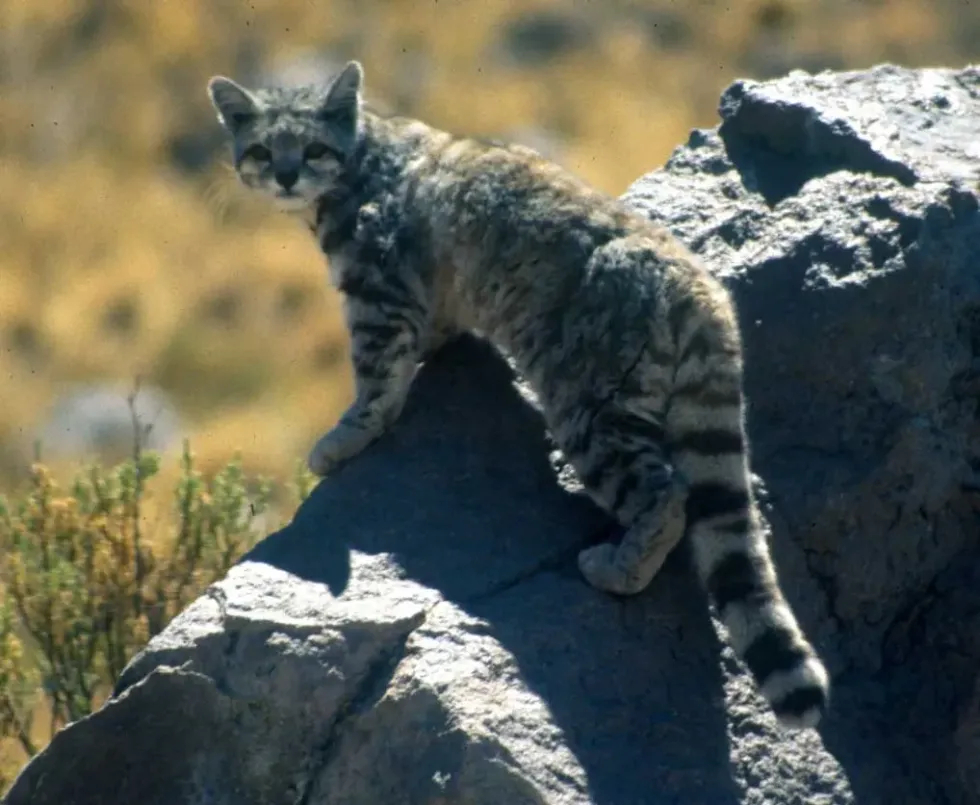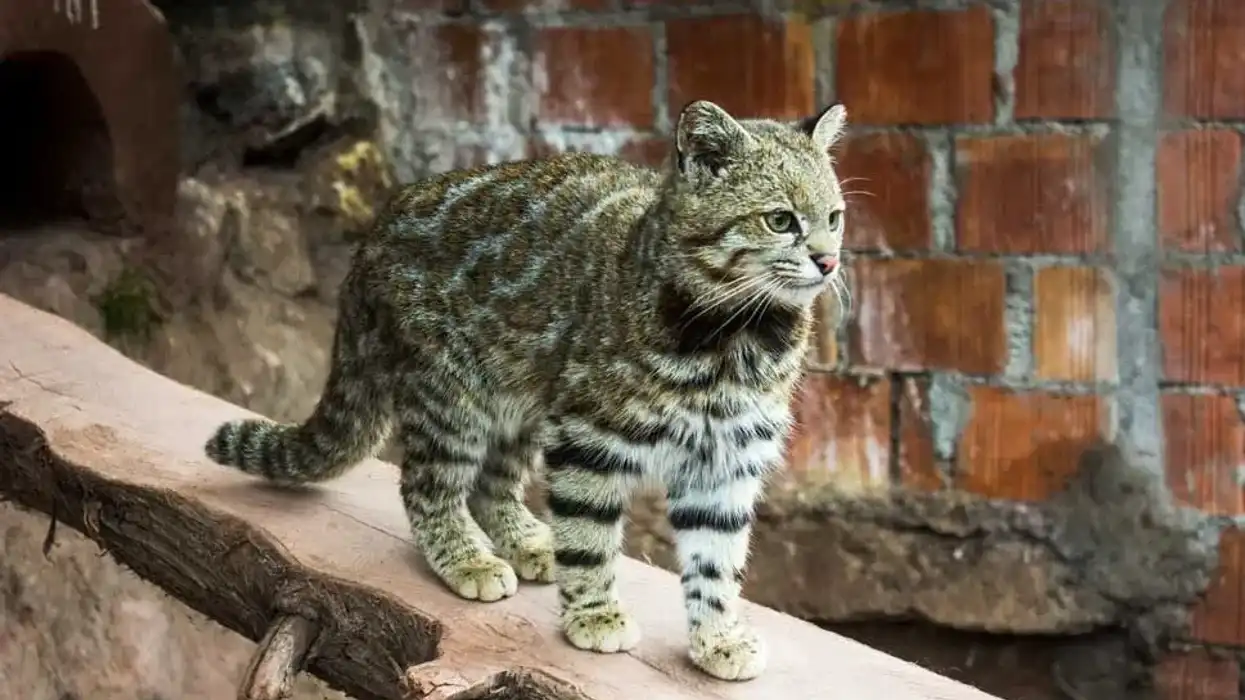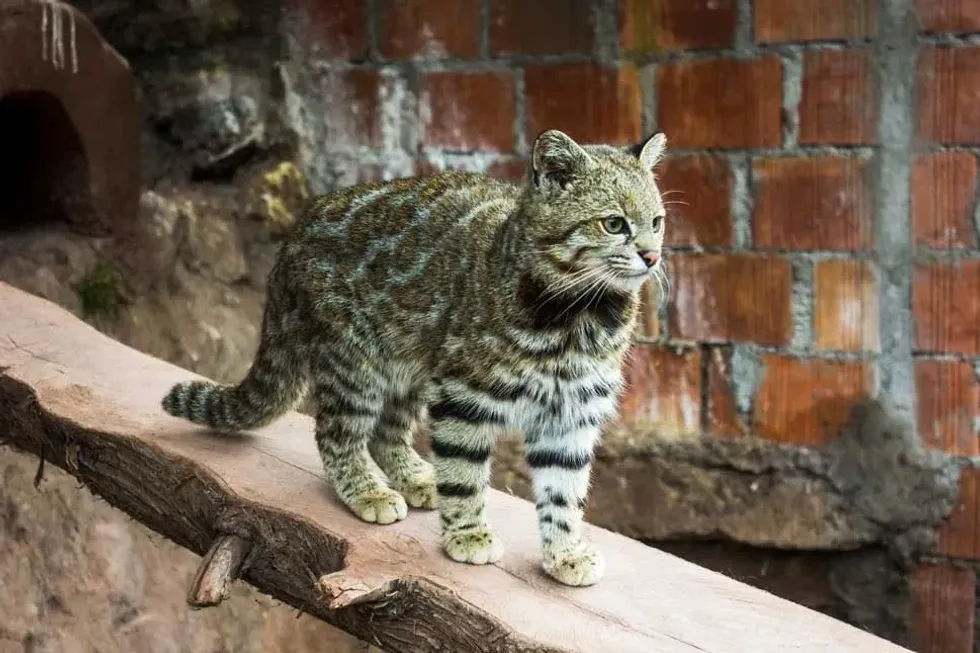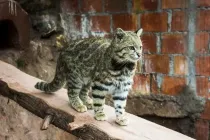Fun Andean Mountain Cat Facts For Kids

Content
- What type of animal is an Andean mountain cat?
- What class of animal does an Andean mountain cat belong to?
- How many Andean mountain cats are there in the world?
- Where does an Andean mountain cat live?
- What is an Andean mountain cat's habitat?
- Who do Andean mountain cats live with?
- How long does an Andean mountain cat live?
- How do they reproduce?
- What is their conservation status?
- What do Andean mountain cats look like?
- How cute are they?
- How do they communicate?
- How big is an Andean mountain cat?
- How fast can an Andean mountain cat run?
- How much does an Andean mountain cat weigh?
- What are the male and female names of the species?
- What would you call a baby Andean mountain cat?
- What do they eat?
- Are they dangerous?
- Would they make a good pet?
- Did you know...
- How does an Andean mountain cat use its tail?
- When do locals and scientists each believe that Andean mountain cats mate?
As beautiful and cute as Andean cats might appear, their exquisiteness has only increased the threats to their life, as they have been known to be hunted for their beautiful pelts.
This has led to them being listed as an Endangered species on the IUCN Red List. Another major reason for the decreasing numbers of these beautiful cats is the loss of their habitat as well as the main food source, due to, yes, human intervention.
They were first described in 1865 and, interestingly, until quite recently most of the information about them was gathered through skulls, pelts, and a few photographs.
However, this only goes on to prove just how rare the Andean cats are.
They are thought to be primarily nocturnal creatures, but some sightings of them during the daylight hours have been confirmed as well.
As they are one of the world's rarest and least-known cats, not much awareness was noticed even in places where their distribution is thought to be relatively more stable. Thankfully some conservation groups are now working hard to keep the population of Andean mountain cat stable, and, you can help too by donating to these organizations.
Well, if you want to learn more interesting facts about Andean mountain cat skin, the habitat of an Andean mountain cat, or about predators of the Andean mountain cat we suggest you keep reading on.
And, if you like reading fun articles like these, please check out South China tiger facts and jaguarundi facts.
Andean Mountain Cat Interesting Facts
What type of animal is an Andean mountain cat?
Andean mountain cats are a type of wild cat native to the mountain region of Northwestern Argentina, Northern Chile, Bolivia, and Peru. The range of their habitat is pretty restricted due to their preferred diet of mountain chinchillas and viscachas.
Unfortunately, the conservation status of this beautiful species of wild cats is listed as Endangered on the IUCN Red List. The main reason is assumed to be habitat loss and the heavy deterioration in the numbers of their favored prey, mountain chinchillas.
What class of animal does an Andean mountain cat belong to?
This endangered species of the Andes mountains belongs to class Mammalia, much like all other species of wild cats. This means that they give birth to live babies instead of laying eggs.
Little is known about their reproduction process, though, as long periods of observation have not been possible when it comes to this species. Their reproduction process is thought to be the same as the pampas cat, who happens to be quite closely related to them.
How many Andean mountain cats are there in the world?
The Andean cat's population has been decreasing noticeably for quite some time due to hunting this beautiful animal for pelts, as well as due to the loss of their preferred habitat and their favorite prey the mountain chinchillas, whose numbers continue to deteriorate because of heavy hunting for their fur.
The Andean cat is now listed as Endangered on the IUCN Red List, and thankfully some measures for their conservation are taken throughout their homelands of Argentina, Chile as well as Bolivia.
It is assumed that there are less than 2500 Andean cats are living in the wild.
Where does an Andean mountain cat live?
Andean cats are known to live in the rocky steppe up high on the Andes mountains that span Argentina, Bolivia as well as Chile and Peru.
What is an Andean mountain cat's habitat?
Andean cats are mostly known for inhabiting arid and semi-arid regions of the Andes mountain range. They are so adapted to their habitat that they will probably not survive for long if they removed from there. There was a record of keeping one in captivity, but unfortunately, it did not survive for longer than a year.
Who do Andean mountain cats live with?
As the Andean cat is elusive in nature, not much is known about its behavior except for its nocturnal nature, though some sightings during the daylight hours are reported as well.
They have been noticed to move in family groups consisting of an adult male, female, and one or two kittens during the breeding season, even though the Leopardus jacobita is thought to be primarily solitary in nature.
How long does an Andean mountain cat live?
Although very little is known about the elusive Andean cat as they prefer to live pretty high up on the Andes mountains, it is assumed that their lifespan is similar to their closely related cousin the Pampas cat, who is known to live as long as 16-17 years on average.
The main threats to them living a long and healthy life can be the drastic deterioration of the numbers of their primary prey, the mountain chinchillas, as well as habitat loss for agricultural and water connection purposes.
Thankfully, some wildlife conservation groups are working hard to protect the population of this endangered species throughout the range of the Andes mountains of Argentina, South Peru, Bolivia, and Chile, where the distribution of the Leopardus jacobita is most noticeable.
How do they reproduce?
Andean cats are thought to breed once a year and are assumed to produce about one to three kittens on average, like the Pampas cats, with whom they share a close relation as well as their habitat. The females take care of the kittens, much like most other wild cat species.
The kittens are thought to be totally dependant on their mothers for nursing and transportation purposes until they are old enough to move and hunt on their own.
What is their conservation status?
The Andean cat is listed as an Endangered species, on the IUCN Red List due to its constantly decreasing population.
The main reason for that is assumed to be the loss of their favorite prey the mountain chinchillas, who have been pushed to the verge of extinction due to reckless hunting for their fur.
Another cause for the endangered tag on this species of wild cats on the conservation list is thought to be the loss of their habitat up on the high Andes mountain range, which spans the South of Peru, as well as Argentina, Chile, and Bolivia.
The Andean cat is also known to be hunted for its beautiful pelt by the poachers, this has contributed to the thinning of their population.
As they are not very large, other threats like larger animals are also known for hunting them, which is yet another reason for their deteriorating population.
Thankfully, some wildlife conservation groups are working to protect the Andean cats throughout the high Andes mountain range, going as far as declaring some places as protected areas where their existence has been confirmed.
Andean Mountain Cat Fun Facts
What do Andean mountain cats look like?

The Andean cats are beautiful with their silver-grayish fur, which is peppered with dark spots. These spots are noticed more on the juveniles than they are on adults.
It is assumed that the number of spots decreases as they age, their fur also lightens in color. The underside of the Andean cat's body is pale and spotted. They also have dark stripes running along the length of their face and body.
They tend to have a long tail, which is ringed with dark-colored bars. The tips, though are sometimes noticed to be white in some Andean cats. The rings tend to be much narrower in the kittens than in adults.
Their long tail helps them to balance their weight and is about 70% of their whole body length. How interesting is that!
How cute are they?
The elusive Andean cat looks very cute with its short body, spotted gray fur, and dark ringed tail.
As this species lives high up on the mountain range they are very hard to find, so unfortunately as cute as the Leopardus jacobita looks, the chances of actually witnessing them out in the wild are very thin, even in places where their distribution is reported to be thick.
It is strange that a lot of wildlife conservation groups are working very hard to protect their population without even expecting to see them in their natural habitat even once in their whole lifetime.
They are so rare that there have only been 10 reported sightings of them in 25 years.
How do they communicate?
Much like their closely related cousin, the Pampas cat, the Andean cat is also thought to communicate through vocalizations as well as tactile means. Chemical scents are also thought to play a part in the communication process of these cats.
How big is an Andean mountain cat?
An adult Andean cat ranges from about 22.7-33.5 in (57.7-85 cm) from head to the body with their tail ranging at about 16.3-19.1 in (41.4-48.5 cm). They are not much bigger than house cats, standing at a shoulder height of about 14 in (35.6 cm) tall.
Interestingly, they have the same height as the body length of a slender-tailed meerkat.
How fast can an Andean mountain cat run?
It is hard to say just how fast an Andean cat can run. Another fact that helps this animal remain away from the human eye is its preferred habitat which ranges quite high on the Andes mountains.
Even in the places where their distribution is relatively on the thicker side, it is close to a miracle to even witness them out and about.
However, they are not known to be very fast runners, preferring to hide in their surroundings than just run away. Their coat helps them to blend in with their surroundings, which in turn allows them to get away from potential predators.
How much does an Andean mountain cat weigh?
As they are not big and heavy creatures and not much sexual dimorphism is noticed among the Andean cat, both the males and females of this species are known to weigh around10-12 lb (4.5-5.4 kg) on average. Please read on to learn more interesting facts about the Andean mountain cat weight.
What are the male and female names of the species?
Much like other wild cat species, the Andean cat does not have sex-specific names for its male and female counterparts. The male Andean cat is just called a male Andean cat, and similarly, the female Andean cat is just called a female Andean cat.
What would you call a baby Andean mountain cat?
As with other small wild cat species, the babies of Andean cats are called kittens. Unfortunately, not much is known about the babies of this cat species except for the fact that they are usually born in April and October.
The babies of the Leopardus jacobita can be confused with their closely related cousins the Pampas cats, who share the same habitat as the Andean cat, as they are more similar in coloration.
What do they eat?
The favorite prey of the Andean cat is mountain chinchillas as well as mountain viscachas, but they have been known to eat other small mammals, like rabbits, tuco tucos as well as some reptiles and birds native to the semi-arid steppe of the Andes mountain range spanning Northern Argentina, Bolivia, Chile as well as the South of Peru.
Are they dangerous?
As the Andean cat is very, very elusive in nature, living high up on the Andes, not much is known about their ferociousness as predators or where they pose a particular danger to humans. But, they are small creatures, so the chances of them being dangerous to humans are small.
They are not much bigger than domestic cats, so, if you can brave the threats posed by the big bad house cat, the Andean cat should not be a matter of huge concern to you.
Would they make a good pet?
They are thought to be solitary, and although they do not show an instinctive fear of humans, just like all other species of wild cats, they do not make good pets.
Their immune system is so adapted to the Andes mountain range, that they will probably not survive for long if they are removed from their natural habitat.
There was one record of keeping one Andean cat in captivity, but it did not survive for more than a year.
Not to mention their diet mostly consists of mountain chinchillas and it is quite an impossible feat for anyone to provide them with that kind of diet plan anywhere outside of their natural habitat where they are free to hunt their prey.
They are also an endangered species with conservation groups working very hard to keep their numbers stable, and it is probably illegal to keep them as pets anyway.
Did you know...
The females tend to give birth to one to three kittens on average, and the kittens are often mistaken for their closely related cousin the Pampas cat, with whom they share their habitat.
They are not known for surviving long in captivity.
How does an Andean mountain cat use its tail?
The Andean cat's long tail spans more than half of its whole body length, well 70% of it to be precise. Interestingly, it is not only for aesthetic purposes, their tail actually helps them to balance their weight when they are chasing their prey and have to move or turn sharply in different directions.
When do locals and scientists each believe that Andean mountain cats mate?
Very little is known about the mating process of the elusive Andean cats, as their numbers are few and sightings are fewer. Locals tend to claim that their mating season spans between the months of July and August.
But, Kittens have been observed in April and October as well, which is why the scientists assume that their breeding season might extend up to the months of November and December as well.
Here at Kidadl, we have carefully created lots of interesting family-friendly animal facts for everyone to discover! Learn more about some other mammals including caracal facts or oncilla facts.
You can even occupy yourself at home by drawing one on our Andean Mountain Cat coloring pages.
We Want Your Photos!
More for You
See All
Bachelor of Arts specializing in Journalism and Mass Communication, Postgraduate Diploma in Sports Management

Moumita DuttaBachelor of Arts specializing in Journalism and Mass Communication, Postgraduate Diploma in Sports Management
A content writer and editor with a passion for sports, Moumita has honed her skills in producing compelling match reports and stories about sporting heroes. She holds a degree in Journalism and Mass Communication from the Indian Institute of Social Welfare and Business Management, Calcutta University, alongside a postgraduate diploma in Sports Management.
Bachelor of Arts specializing in Economics

Gowri RaoBachelor of Arts specializing in Economics
With a bachelor's degree in Economics from Krea University, Gowri is a highly skilled data analyst and an expert in regression and causation modeling. Her interests in economic trends, finance, and investment research complement her professional expertise. In addition to her professional pursuits, Gowri enjoys swimming, running, and playing the drums, and she is also a talented tutor.
Disclaimer
1) Kidadl is independent and to make our service free to you the reader we are supported by advertising. We hope you love our recommendations for products and services! What we suggest is selected independently by the Kidadl team. If you purchase using the Buy Now button we may earn a small commission. This does not influence our choices. Prices are correct and items are available at the time the article was published but we cannot guarantee that on the time of reading. Please note that Kidadl is a participant in the Amazon Services LLC Associates Program, an affiliate advertising program designed to provide a means for sites to earn advertising fees by advertising and linking to Amazon. We also link to other websites, but are not responsible for their content.
2) At Kidadl, we strive to recommend the very best activities and events. We will always aim to give you accurate information at the date of publication - however, information does change, so it’s important you do your own research, double-check and make the decision that is right for your family. We recognise that not all activities and ideas are appropriate for all children and families or in all circumstances. Our recommended activities are based on age but these are a guide. We recommend that these ideas are used as inspiration, that ideas are undertaken with appropriate adult supervision, and that each adult uses their own discretion and knowledge of their children to consider the safety and suitability. Kidadl cannot accept liability for the execution of these ideas, and parental supervision is advised at all times, as safety is paramount. Anyone using the information provided by Kidadl does so at their own risk and we can not accept liability if things go wrong.
3) Because we are an educational resource, we have quotes and facts about a range of historical and modern figures. We do not endorse the actions of or rhetoric of all the people included in these collections, but we think they are important for growing minds to learn about under the guidance of parents or guardians.







